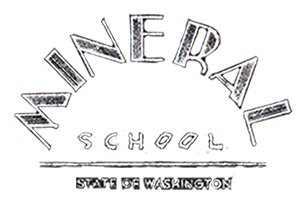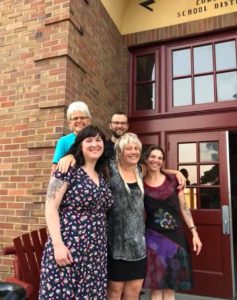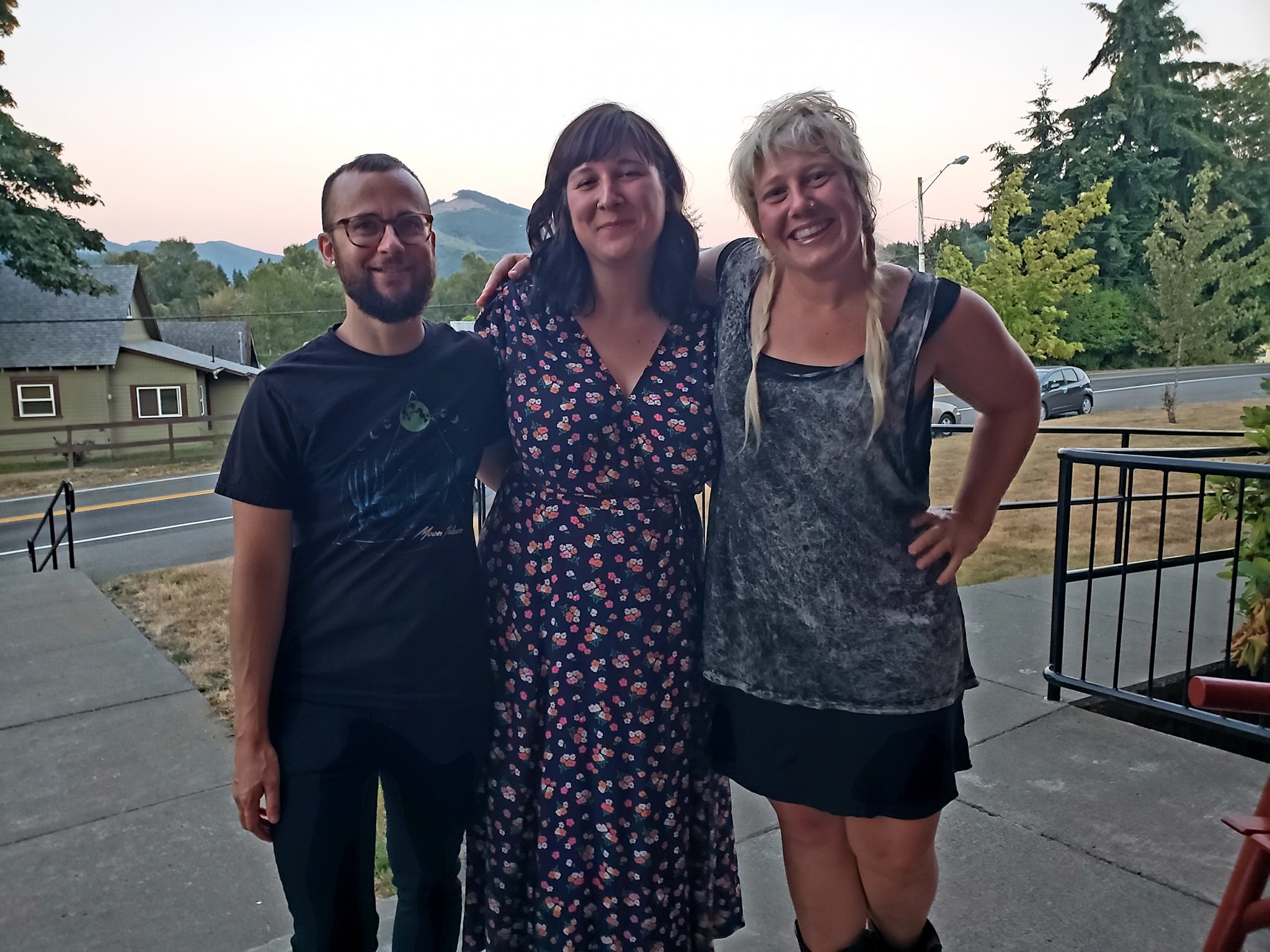Blog
Meet a Resident: Meg Hartwig
Multi-media artist Meg Hartwig (’18), front and center, builds, bakes, bikes, advocates and educates. Her keen eye for detail reverberates in everything from 10-foot high art installations in public spaces to more intimate inch-long carvings of tools. Meg was Mineral School’s inaugural recipient of the Mona Lisa Roberts fellowship for an LGBTQ artist. Prior to her residency in July 2018, a cycling accident left Meg with major physical injuries and a severe brain injury. She began to draw again while at Mineral—a break-through moment in her healing. Putsata Reang (’17) spoke with Meg at her studio in Seattle’s industrial/artistic Georgetown neighborhood about her life and art, and her intrinsic need to create.
Why do you make art?
I feel most healthy when I’m making (art) work. It is a gut need. It’s a comfort. When I got hit and I couldn’t do it, I didn’t know who I was. I got lost. At the core level, I think there are a lot of questions that need to be raised in human societies. I’m not at all pointing at answers as much as trying to raise questions. I am working around ideas of constructs of power and control, which I talk a lot about in my work. I’m trying to raise questions on a societal level. If the work can start triggering some questions in people, I’m gonna be pretty happy.
Did you grow up in an artistic family? Who encouraged you to be an artist?
I came from a Catholic working-class family in Michigan. I wasn’t going to fancy art schools. My mom ran a childcare and my dad ran a gerontology network. My dad was a psychologist, and I guarantee that is in my work. My great-aunt, who died when I was 2 years old, was a sculptor, and her husband was a sculptor and my dad thought of them very highly. They were in Greenwich Village. My parents saw I was neurotically separating things and showing being an artist at a young age. My dad encouraged it, not in the way of, “Here are these art classes,” but in the way of, “It’s ok.” There was an understanding at the get-go: “You’re an artist. You’re a weirdo.”
What was the first piece of art you loved?
I’m highly inspired by folks who just need to make. Lou Boylan, who sequined their whole house. I remember seeing “Mad Love” when I was a teenager and Casey (played by Drew Barrymore) put eyes all over the walls. I remember seeing that and thinking, “That’s so amazing.”
Can you talk a little bit about your process? How do ideas germinate for you and then manifest physically in your art studio and/or work space?
A lot of times, I’ll think of something and two years later, I’ll make something. Right now, I’m thinking a lot of being erased. My partner left me while I was at Mineral. I was sobbing, thinking, “I can’t believe I’m being erased by my partner.” After gettin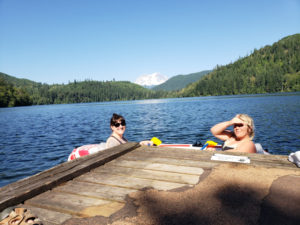 g hit on my bike, I felt like I was being erased by my brain injury. Erasure comes back into my head every week, maybe every day. I guarantee that will come into fruition at some point. I know I will have a body of work about erasure. In the same way I was at Mineral School, thinking a lot about lahars. It’s when Rainier blows, the ash will follow a certain path. I was in my room in Mineral drawing where the lahar will go. It will make a work at some point. These are things I started when I was walking around Mineral and Rainier and thinking about what people kept saying: “We’re not in the lahar zone.” I kept thinking: “I am.” That’s the PTSD from the accident. That is how things germinate, from daily experience. I’ll have a thought. Then it starts becoming obsessive in different ways. Eventually, it gets made into something.
g hit on my bike, I felt like I was being erased by my brain injury. Erasure comes back into my head every week, maybe every day. I guarantee that will come into fruition at some point. I know I will have a body of work about erasure. In the same way I was at Mineral School, thinking a lot about lahars. It’s when Rainier blows, the ash will follow a certain path. I was in my room in Mineral drawing where the lahar will go. It will make a work at some point. These are things I started when I was walking around Mineral and Rainier and thinking about what people kept saying: “We’re not in the lahar zone.” I kept thinking: “I am.” That’s the PTSD from the accident. That is how things germinate, from daily experience. I’ll have a thought. Then it starts becoming obsessive in different ways. Eventually, it gets made into something.
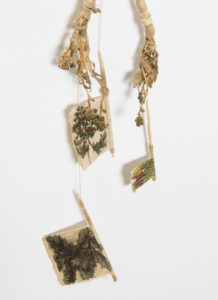 Your connection with nature and the natural world are evident in your work (ie. the “Preserve” series” where you take plants you grew from seed and intentionally preserved them in beeswax). What is it about nature that so captivates you?
Your connection with nature and the natural world are evident in your work (ie. the “Preserve” series” where you take plants you grew from seed and intentionally preserved them in beeswax). What is it about nature that so captivates you?
Most of my work in conversation with the natural world. How systems work is what I’m obsessed with. I’m constantly and sometimes subconsciously trying to relate that all of us are inter-connected and the systems are the same if you start looking closely. These constructions of power and control that humans have made, this monoculture.. it doesn’t work. In the “Preserve” project (see a piece from it at left), I was living in a house and breaking up with my partner. We were big gardeners. I started uprooting our plants. We had eaten all the food. I was looking at the root structure in the garden. The roots were both symbolically beautiful and they were so twisted and messed up. I was washing all my plants and saving them. Before I knew it, I was obsessed with them. Before I knew it was dipping them in beeswax. It took making three of them before I realized, I was mummifying them. I knew I was leaving that house, I knew I was leaving her, I knew I was leaving our garden, I was trying to preserve everything: the plant, the seed, the labor, the nourishment.
How do you choose what materials to use?
A lot of times, it’s the meaning of the material. There is a lot of history in the materials I use. I used to dig bricks out of the Duwamish 10 years ago. I was obsessed with the color of pollution and I was obsessed the bricks were there because something was knocked down. I collected bull kelp to make an installation that hung on a pedestrian bridge at Carkeek Park. The bull kelp was imperative to saying something about the land I live on. You could see a line through all of (my work) on power and control. I built a 10-foot installation from trash. What is trash and what is art? What has value? What doesn’t have value? Half of my work is made from trash.
In the literary world, we talk about a literary throughline – a sort of invisible thread that binds a story. This can be theme or plot or even language. Is there an artistic throughline in your artwork that ties your pieces together, or are your projects more stand-alone pieces?
 Obsession to detail is what comes through. (See a slide of one of Meg’s sculptures which she showed at residents’ “Show & Tell” night at left.) Craftsmanship — I’m a nut about it. It’s the same with everything I do, even when I teach carpentry to youth. All of my questions are about constructs of power and control that enforce imbalance, that is the thread. As I am making (an art piece) and it’s tedious and it’s taking months, I’m thinking about how this relates to me personally, socio-culturally, and ecologically.
Obsession to detail is what comes through. (See a slide of one of Meg’s sculptures which she showed at residents’ “Show & Tell” night at left.) Craftsmanship — I’m a nut about it. It’s the same with everything I do, even when I teach carpentry to youth. All of my questions are about constructs of power and control that enforce imbalance, that is the thread. As I am making (an art piece) and it’s tedious and it’s taking months, I’m thinking about how this relates to me personally, socio-culturally, and ecologically.
You are the first artist I’ve met who let me pick up and touch their art. Have you ever tried to touch something you weren’t supposed to in a museum or gallery?
I am so sorry you have not had the holistic reward of touching a sculptor’s work! I feel like not holding / touching a sculpture (art) is like only eating a chef’s meal- without seeing or smelling it. Without touching my work, you are only getting a portion of the experience. There is a lot of meaning in the material. Tactility, weight, texture, smell, my/our fingerprints, user-experience, relationship, etc… Not to mention getting close enough to smell it, see it clearly, to use it? (my bullroarers, cell phones, bricks, cups, tools, vessels, masks, etc) and have a personal relationship with it. I am educated in the realm of WHY we do not touch art. And I use that knowledge when I decide to touch a piece of art or choose not to. Yes, I have touched work in galleries. And yes, I have been asked to leave. To end: Please touch my art always.
What keeps you busy when you’re not making art? How and where do you make time in your day for your art?
Well, I will write as If I am not recovering from a severe accident. Because I have lived many years functionally operating before this year. And the truth is, I am on a rapid road to recovery at this point and I have re-gained many, but not all, of my daily operations. And I hope to re-invigorate all of them by the time I am healed.
My “9-5” (which is nowhere close to a “9-5”) is working as a Program Manager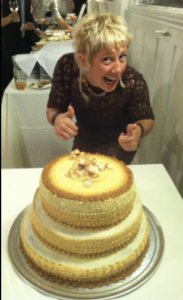 at Sawhorse Revolution, a non-profit that focuses on Design and Carpentry Youth Education in and for our community. I am one of the few cogs of this small and mighty machine. This feeds my drive to continue Education around the value in the act-of-making/invention/innovative thought …..which is rapidly continuing to be eradicated from institutional Education systems. And also feeds my drive to WORK for social justice and racial/gender/ethnic equity at a hands-on-the-ground level to creating new systems and leads of operation and power.
at Sawhorse Revolution, a non-profit that focuses on Design and Carpentry Youth Education in and for our community. I am one of the few cogs of this small and mighty machine. This feeds my drive to continue Education around the value in the act-of-making/invention/innovative thought …..which is rapidly continuing to be eradicated from institutional Education systems. And also feeds my drive to WORK for social justice and racial/gender/ethnic equity at a hands-on-the-ground level to creating new systems and leads of operation and power.
I am an adventure cyclist. My favorite thing was once exploring through bike commuting, touring and bike-packing. Your senses are on fire when you get to explore the world without a wall/barrier between your body and it. Biking has been my release, my brainstorming engine, my time, my health, and my transportation through thousands of miles and conversations. I feel more connected to the system of the natural and human made world when I am commuting/touring. It’s and awareness engine. I will get back on the horse, on the regular, I hope. In time.
I am constantly doing. My hands are constantly busy. My brain, especially when recovered, is constantly turned on and thinking about new lenses to see out of. Better understanding the history of the land/space I am on/in and the body/brain I am inhabit is common place. Cooking for the folks I love and baking/decorating cakes for super special occasions is one of my things. I love it. It’s just another medium for creating, experiencing and ingestion.
What are you working on now?
Carving little spoons. I love clay spoons. Right now, I’m going back to the comfort of working with my hands. Carving comes innately. I wanted to make this domestic item. It brings comfort, and I’ve really needed that.
